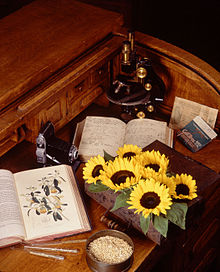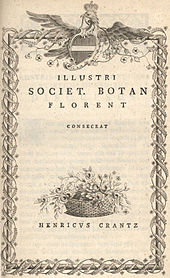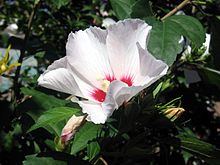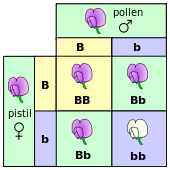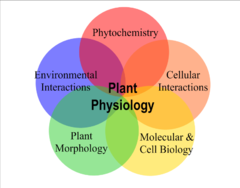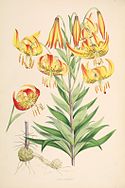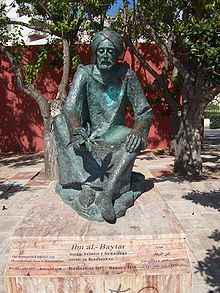
Botany
Background Information
SOS Children have produced a selection of wikipedia articles for schools since 2005. Click here for more information on SOS Children.
Botany, plant science(s), or plant biology (from Ancient Greek βοτάνη botane, " pasture, grass, or fodder" and that from βόσκειν boskein, "to feed or to graze"), is a discipline of biology and the science of plant life. Traditionally, the science included the study of fungi, algae, and viruses. A person engaged in the study of botany is called a botanist.
Botany covers a wide range of scientific disciplines including structure, growth, reproduction, metabolism, development, diseases, chemical properties, and evolutionary relationships among taxonomic groups. Botany began with early human efforts to identify edible, medicinal and poisonous plants, making it one of the oldest branches of science. Nowadays, botanists study about 400,000 species of living organisms.
The beginnings of modern-style classification systems can be traced to the 1500s–1600s when several attempts were made to scientifically classify plants. In the 19th and 20th centuries, major new techniques were developed for studying plants, including microscopy, chromosome counting, and analysis of plant chemistry. In the last two decades of the 20th century, DNA was used to more accurately classify plants.
Botanical research focuses on plant population groups, evolution, physiology, structure, and systematics. Sub-disciplines of botany include agronomy, forestry, horticulture, and paleobotany. Key scientists in the history of botany include Theophrastus, Ibn al-Baitar, Carl Linnaeus, Gregor Mendel, and Norman Borlaug.
History
Early botany
The history of botany includes many ancient writings and classifications of plants found in several early cultures. Examples of early botanical works have been found in ancient sacred texts from India, ancient Zoroastrian writings, and ancient Chinese works.
Modern botany traces its roots back more than twenty three centuries, to the Father of Botany, Theophrastus (c. 371–287 BC), a student of Aristotle. He invented and described many of the principles of modern botany. His two major works, Enquiry into Plants and On the Causes of Plants constitute the most important contribution to botanical science during antiquity and the Middle Ages, and held that position for some seventeen centuries after they were written. Also from Greece, Pedanius Dioscorides, in the middle of the first century, wrote De Materia Medica, a five-volume encyclopedia about herbal medicine that was widely read for more than 1,500 years. Works from the medieval Muslim world included Ibn Wahshiyya's Nabatean Agriculture, Abū Ḥanīfa Dīnawarī's (828–896) the Book of Plants, and Ibn Bassal's The Classification of Soils. In the early 13th century, Abu al-Abbas al-Nabati, and Ibn al-Baitar (d. 1248) also wrote on botany.
Early modern botany
German physician Leonhart Fuchs (1501–1566) was one of "the three German fathers of botany", along with Otto Brunfels (1489–1534) and Hieronymus Bock (1498–1554) (also called Hieronymus Tragus).
Valerius Cordus (1515–1544) authored a pharmacopoeia of lasting importance, the Dispensatorium in 1546. Conrad von Gesner (1516–1565) and Nicholas Culpeper (1616–1654) also published herbals covering the medicinal uses of plants. Ulisse Aldrovandi (1522–1605) was considered the "father of natural history", which included the study of plants. In 1665, using an early microscope, Robert Hooke discovered cells, a term he coined, in cork, and a short time later in living plant tissue.
During the 18th century, systems of classification were developed that are comparable to diagnostic keys, where taxa are artificially grouped in pairs. The sequence of the taxa in keys is often unrelated to their natural or phyletic groupings. By the 18th century an increasing number of new plants had arrived in Europe from newly discovered countries and the European colonies worldwide and a larger number of plants became available for study. Botanical guides from this time were sparsely illustrated. In 1754 Carl von Linné (Carl Linnaeus) divided the plant Kingdom into 25 classes in a taxonomy with a standardized binomial naming system for animal and plant species. He used a two-part naming scheme where the first name represented the genus and the second the species. One of Linnaeus' classifications, the Cryptogamia, included all plants with concealed reproductive parts (mosses, liverworts and ferns), and algae and fungi.
The increased knowledge of anatomy, morphology and life cycles, led to the realization that there were more natural affinities between plants than the sexual system of Linnaeus indicated. Adanson (1763), de Jussieu (1789), and Candolle (1819) all proposed various alternative natural systems that were widely followed. The ideas of natural selection as a mechanism for evolution required adaptations to the Candollean system, which started the studies on evolutionary relationships and phylogenetic classifications of plants.
Botany was greatly stimulated by the appearance of the first "modern" text book, Matthias Schleiden's Grundzuge der Wissenschaftlichen, published in English in 1849 as Principles of Scientific Botany. Carl Willdenow examined the connection between seed dispersal and distribution, the nature of plant associations, and the impact of geological history. The cell nucleus was discovered by Robert Brown in 1831.
Modern botany
A considerable amount of new knowledge comes from studying model plants such as Arabidopsis thaliana. This weedy species in the mustard family ( Brassicaceae) was one of the first plants to have its genome sequenced. The sequencing of the rice (Oryza sativa) genome, its relatively small genome, and a large international research community have made rice an important cereal/ grass/ monocot model. Another grass species, Brachypodium distachyon is also an experimental model for understanding genetic, cellular and molecular biology. Other commercially important staple foods like wheat, maize, barley, rye, pearl millet and soybean are also having their genomes sequenced. Some of these are challenging to sequence because they have more than two haploid (n) sets of chromosomes, a condition known as polyploidy, common in the plant kingdom. A green alga, Chlamydomonas reinhardtii, is a model organism that has proven important in advancing knowledge of cell biology.
In 1998 the Angiosperm Phylogeny Group published a phylogeny of flowering plants based on an analysis of DNA sequences from most families of flowering plants. As a result of this work, many of the questions such as which families represent the earliest branches of angiosperms have now been answered. Investigating how plant species are related to each other allows botanists to better understand the process of evolution in plants. Despite the study of model plants and increasing use of DNA evidence, there is ongoing work and discussion among taxonomists about how best to classify plants into various taxa.
Scope and importance of botany
Molecular, genetic and biochemical level through organelles, cells, tissues, organs, individuals, plant populations, and communities of plants are all aspects of plant life that are studied. At each of these levels, a botanist may be concerned with the classification ( taxonomy), structure ( anatomy and morphology), or function ( physiology) of plant life.
Historically, all living things were grouped as either animals or plants, and botany covered the study of all organisms not considered to be animals. Now, plants are considered to be organisms that obtain their energy from sunlight through photosynthesis, and other closely related, chlorophyll-free parasitic plants. Organisms previously studied in the field of botany include bacteria (studied in bacteriology), fungi ( mycology)—including lichen-forming fungi ( lichenology), non- chlorophyte algae ( phycology), and viruses ( virology). However, attention is still given to these groups by botanists, and fungi (including lichens) and photosynthetic protists are usually covered in introductory botany courses.
The study of plants is vital because they are a fundamental part of life on Earth, and generate the oxygen and food that allow humans and other organisms to exist. Through photosynthesis, plants absorb carbon dioxide, a greenhouse gas that in large amounts can affect global climate. Just as importantly for humans, plants release oxygen into the atmosphere during photosynthesis. Additionally, they prevent soil erosion and are influential in the water cycle. Plants are crucial to the future of human society as they provide food, oxygen, medicine, and products for people; as well as creating and preserving soil. Paleobotanists study ancient plants in the fossil record. The evolution of photosynthetic plants early in the Earth's history altered the atmosphere of the Earth, changing the ancient atmosphere through oxidation.
Human nutrition
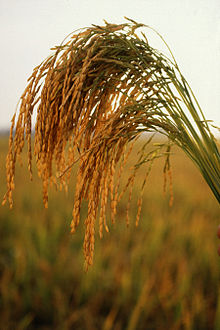
Virtually all foods come either directly from plants, or indirectly from animals that eat plants. Plants are the fundamental base of nearly all food chains because they use the energy from the sun and nutrients from the soil and atmosphere, converting them into a form that can be consumed and utilized by animals; this is what ecologists call the first trophic level. Botanists also study how plants produce food we can eat and how to increase yields and therefore their work is important in mankind's ability to feed the world and provide food security for future generations, for example, through plant breeding. Botanists also study weeds, plants which are considered to be a nuisance in a particular location. Weeds are a considerable problem in agriculture, and botany provides some of the basic science used to understand how to minimize 'weed' impact in agriculture and native ecosystems. Ethnobotany is the study of the relationships between plants and people. When this kind of study is turned to the investigation of plant-people relationships in past times, it is referred to as archaeobotany or paleoethnobotany.
Fundamental life processes
Botanical research has long had relevance to the understanding of fundamental biological processes other than just botany. Fundamental life processes such as cell division and protein synthesis can be studied using plants without the moral issues that come with conducting studies upon animals or humans. Gregor Mendel discovered the genetic laws of inheritance in this fashion by studying Pisum sativum (pea) inherited traits such as shape. What Mendel learned from studying plants has had far reaching benefits outside of botany. Similarly, ' jumping genes' were discovered by Barbara McClintock while she was studying maize.
Medicine and materials
Many medicinal and recreational drugs, like tetrahydrocannabinol, caffeine, and nicotine come directly from the plant kingdom. Others are simple derivatives of botanical natural products; for example, the pain killer aspirin is derived from salicylic acid which originally came from the bark of willow trees. As well, the narcotic analgesics such as morphine are derived from the opium poppy. There may be many novel cures for diseases provided by plants, waiting to be discovered. Popular stimulants like coffee, chocolate, tobacco, and tea also come from plants. Most alcoholic beverages come from fermenting plants such as barley (beer), rice ( sake) and grapes (wine).
Hemp, cotton, wood, paper, linen, vegetable oils, some types of rope, and rubber are examples of materials made from plants. Silk can only be made by using the mulberry plant. Sugarcane, rapeseed, soy are some of the plants with a highly fermentable sugar or oil content which have recently been put to use as sources of biofuels, which are important alternatives to fossil fuels (see biodiesel).
Environmental changes
In many different ways, plants can act a little like the ' miners' canary', an early warning system alerting us to important changes in our environment. Plants respond to and provide understanding of changes in the environment:
- Plant systematics and taxonomy are essential to understanding habitat destruction and species extinction.
- Ultraviolet radiation causes changes in plants which help in studying problems like ozone depletion.
- Analyzing pollen found in fossils and sediment from thousands or millions of years ago allows reconstruction of past climates and the prediction of future ones. This is essential to climate change research.
- Study of plant life cycles is an important part of phenology, which is used in climate-change research.
Ecology
The biology of a population is greater than the collective biologies of its individuals. Multiple members of the same species in close proximity constitute a population. Different populations in proximity constitute a community, which in conjunction with its nonliving environment constitute an ecosystem. The relation of each organism to all other organisms and factors in its habitat and environment make up its ecology. This includes structure, genetics and mutations, metabolism, diversity, fitness, adaptation, climate, water, and soil condition. The conditions that constitute an organisms life cycle is its habitat. Both negative and beneficial interactions with other organisms are parts of a plant's ecology. Herbivores eat plants, but plants can also defend themselves. Some other organisms form beneficial relationships with plants, called mutualisms, for example with mycorrhizal fungi that provide nutrients, and honey bees that pollinate flowers. A biome is a large part of the earth that has very similar abiotic and biotic factors, climate, and geography, creating a typical ecosystem over that area that is characterized by its dominant plants. Examples include tundra and tropical rainforest.
Evolution
DNA provides the information for a plant's structure, metabolism, and biology. Genetics is the science of inheritance and the gene is its chemical unit. The same basic laws of genetics apply to both plants and animals. In sexual reproduction, offspring are often more fit than either parent since the stronger genes tend to be passed on to the next generation. Mutations and natural selection result in a species acquiring new traits and eventually evolving into one or more new species. Population genetics is the study of allele frequency distribution and change under the influence of the four main evolutionary processes: natural selection, genetic drift, mutation and gene flow. Changes can also be caused by natural events such as a large meteor hitting Earth and selective breeding (artificial selection) of plants by humans for specific traits.
Since the mid-20th century, there has been considerable debate over how the earliest forms of life evolved and how to classify them, especially at the kingdom and domain levels and organisms that are or have been considered bacteria. For example, the three-domain system separates Archaea and Bacteria, previously grouped into the single kingdom Monera (bacteria). Archaea was separated because it was shown to have a different evolutionary history. However, Thomas Cavalier-Smith rejects the three-domain system and places the Archaea as a subkingdom of Bacteria. Cyanobacteria were once believed to be related to algae and hence studied by botanists. Even now they are studied by both botanists and bacteriologists. Similarly, the Fungi (or Myceteae) were once considered plants but there is now uncertainty about how to classify them.
The various divisions of algae are also taxonomically problematic as some are more clearly linked to plants than others. Their many differences in features such as biochemistry, pigmentation, and nutrient reserves show that they diverged very early in evolutionary time. The division Chlorophyta (green algae) is considered the ancestor of true plants.
Nonvascular plants are embryophytes that do not have vascular tissue: mosses, liverworts, and hornworts. Many plants that are called "moss" are not true mosses. For example, Spanish moss (Tillandsia usneoides) is actually in the Bromeliaceae (pineapple) family. Nonvascular plants do not have xylem nor phloem. After the development of xylem and phloem, vascualar plants developed along two lines: cryptogams which reproduce by spores and which developed first, and spermatophytes, which reproduce by seed. The spermatophytes further developed into gymnosperms, plants that produce seeds not enclosed in an ovary. Modern gymnosperms include conifers, cycads, Ginkgo, and Gnetales. Gymnosperms are the ancestors of the Angiosperms or flowering plants which produce a seed encased in a structure such as a carpel.
Physiology
Plant physiology encompasses all the internal chemical and physical activities of plants associated with life. Sunlight, either through photosynthesis or cellular respiration, is the basis of all life. Photoautotrophs gather energy directly from sunlight. This includes all green plants, cyanobacteria and other bacteria that can photosynthesize. Heterotrophs take in organic molecules and respire them. This includes all animals, all fungi, all completely parasitic plants, and non-photosynthetic bacteria. Respiration is the oxidation of carbon whereby it is broken down into simpler structures; essentially the opposite of photosynthesis.
Transport processes are those by which molecules are moved within the organism, such as: membranes transporting material across themselves and enzymes moving electrons. This is how minerals and water get from roots to other parts of the plant. Diffusion, osmosis, and active transport are different ways transport can occur. Examples of elements that plants need are: nitrogen, phosphorus, calcium, magnesium, and sulphur. Chemicals from the air, soil, and water in combination with sunlight form the basis of plant metabolism. Most of these elements come from minerals in a process called mineral nutrition. Few plants live in stable unchanging environments. Most plants must adapt to a variety of environmental factors, including changes in temperature, light and moisture. The better a plant can cope with these changing conditions, the more likely it is to be able to survive over both the short and long term as well as establish itself over a wider geographic range.
Structure
Plant anatomy is the study of the internal cells and tissues of a plant; whereas plant morphology is the study of their general and external form.
Understanding the structure and function of cells is fundamental to all of the biological sciences. All organisms have cells, the cell types are unique and their nuclei store most of the DNA. Cell biology studies their structural and physiological properties. This includes responses to stimuli, reproduction, and development on the macroscopic scale, microscopic scale, and molecular level. The similarities and differences between the function of a cell are quite varied. Plant cells are eukaryotic, i.e., have a membrane-encased nucleus that carries genetic material. With rare exceptions, plant cells also have a central vacuole, cytoplasm, cytosol, dictyosomes, endoplasmic reticulum, microbodies, microfilaments, microtubules, mitochondria, plasma membrane, plastids, protoplasm, ribosomes, storage products, and a cell wall. Cells divide by processes known as karyokinesis and cytokinesis.
The body of a plant contains three basic parts: roots, stems, and leaves. Roots anchor it to the ground, gather water and mineral nutrients from the soil, and produce hormones. Roots which spread out close to the surface, such as those of willows, can produce shoots and ultimately new plants. Fleshy taproots, such as those of beets and carrots, store carbohydrates. Stems provide support to the leaves and store nutrients. Leaves gather sunlight and begin photosynthesis. Large, flat, flexible, green leaves are called foliage leaves. Gymnosperms are seed-producing plants which have open seeds, such as conifers, cycads, Ginkgo, and gnetophyta. Angiosperms are seed-producing plants that produce flowers, having enclosed seeds. Some of the gymnosperms became the ancestors of the angiosperms. Woody plants, such as azaleas and oaks, undergo a secondary growth phase resulting in two additional types of tissues: wood (secondary xylem) and bark (secondary phloem and cork). All gymnosperms and many angiosperms are woody plants. Some plants reproduce sexually, some asexually, and some via both means.
Systematics
Scientific classification in botany is a method by which botanists group and categorize organisms by biological type, such as genus or species. Biological classification is a form of scientific taxonomy. Modern taxonomy is rooted in the work of Carolus Linnaeus, who grouped species according to shared physical characteristics. These groupings have since been revised to improve consistency with the Darwinian principle of common descent. While scientists do not always agree on how to classify organisms, molecular phylogenetics, which uses DNA sequences as data, has driven many recent revisions along more efficient, evolutionary lines and is likely to continue to do so. Botanical classification belongs to the science of plant systematics. The dominant classification system is called the Linnaean taxonomy. It includes ranks and binomial nomenclature. The classification, taxonomy, and nomenclature of botanical organisms is administered by the International Code of Nomenclature for algae, fungi, and plants (ICN).
The five-kingdom system has largely been superseded by modern alternative classification systems. Textbooks generally begin with the three-domain system: Archaea (originally Archaebacteria); Bacteria (originally Eubacteria); Eukaryota (including protists, fungi, plants, and animals). These domains reflect whether the cells have nuclei or not, as well as differences in the chemical composition of the cell exteriors and ribosomes.
Further, each kingdom is broken down recursively until each species is separately classified. The order is: Domain; Kingdom; Phylum; Class; Order; Family; Genus; Species. The scientific name of an organism is generated from its genus and species, resulting in a single world-wide name for each organism. For example, the Tiger Lily is listed as Lilium columbianum. Lilium is the genus, and columbianum the specific epithet. When writing the scientific name of an organism, it is proper to capitalize the first letter in the genus and put all of the specific epithet in lowercase. Additionally, the entire term is ordinarily italicized or underlined. Phylogenetics is the study of similarities among different species.
Notable botanists
The following botanists made major contributions to the ways in which botany has been studied.
- Theophrastus (c. 371 – c. 287 BC), "The Father of Botany", established botanical science through his lecture notes, Enquiry into Plants.
- Pedanius Dioscorides (c. 40–90 AD), Greek physician, pharmacologist, toxicologist and botanist, author of De Materia Medica (Regarding Medical Matters).
- Abū Ḥanīfa Dīnawarī (828–896), Persian, Kurdish or Arab botanist, historian, geographer, astronomer, mathematician, and founder of Arabic botany.
- Su Song (1020–1101), Chinese polymath, botanist, compiled the Bencao Tujing ('Illustrated Pharmacopoeia'), a treatise on pharmaceutical botany, zoology, and mineralogy.
- Abu al-Abbas al-Nabati (c. 1200), Andalusian-Arab botanist and agricultural scientist, and a pioneer in experimental botany.
- Ibn al-Baitar (1197–1248), Andalusian-Arab scientist, botanist, pharmacist, physician, and author of one of the largest botanical encyclopedias.
- Leonardo da Vinci (1452–1519), Italian polymath; a scientist, mathematician, engineer, inventor, anatomist, painter, sculptor, architect, botanist, musician and writer.
- John Ray (1627–1705), English naturalist, botanist, and zoologist; father of natural history.
- Augustus Quirinus Rivinus (1652–1723), German physician and botanist; introduced the concept of classifying plants based on the structure of their flower, which influenced de Tournefort and Linnaeus.
- Joseph Pitton de Tournefort (1656–1708), French botanist; first to clearly define the concept of genus for plants.
- Carl Linnaeus (1707–1778), Swedish botanist, physician and zoologist who laid the foundations for the modern scheme of Binomial nomenclature; known as the father of modern taxonomy and also considered one of the fathers of modern ecology.
- Jean-Baptiste Lamarck, (1744–1829), French naturalist, botanist, biologist, academic, and an early proponent of the idea that evolution occurred and proceeded in accordance with natural laws.
- Aimé Bonpland (1773–1858), French explorer and botanist, who accompanied Alexander von Humboldt during five years of travel in Latin America.
- Augustin Pyramus de Candolle (1778–1841), Swiss botanist, originated the idea of "Nature's war", which influenced Charles Darwin.
- David Douglas (1799–1834), Scottish botanical explorer of North America and China, who imported many ornamental plants into Europe.
- Richard Spruce (1817–1893), English botanist and explorer who carried out a detailed study of the Amazon flora.
- Joseph Dalton Hooker (1817–1911), English botanist and explorer; second winner of Darwin Medal.
- Gregor Johann Mendel (1822–1884), Austrian Augustinian priest and scientist, and is often called the father of genetics for his study of the inheritance of traits in pea plants.
- Charles Sprague Sargent (1841–1927), American botanist, the first director of the Arnold Arboretum at Harvard University.
- Agustín Stahl (1842–1917), Puerto Rican doctor, who conducted investigations and experiments in the fields of botany, ethnology, and zoology in the Caribbean region.
- Luther Burbank (1849–1926), American botanist, horticulturist, and a pioneer in agricultural science.
- George Ledyard Stebbins, Jr. (1906–2000), American widely regarded as one of the leading evolutionary biologists of the 20th century, developed a comprehensive synthesis of plant evolution incorporating genetics.
- Norman Borlaug (1914–2009), American agronomist, known for breeding high yielding wheat varieties. Dubbed the "father of the green revolution"
- Richard Evans Schultes (1915–2001), American botanist and explorer, known as "The Father of Ethnobotany", Linnean Society gold medal winner.

